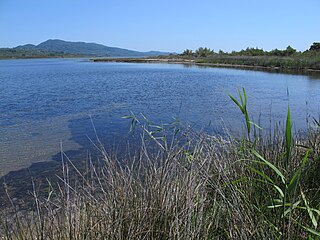Victor Gruschka Springer was an American biologist who was a Senior Scientist emeritus, Division of Fishes at the Smithsonian Institution's National Museum of Natural History in Washington, D.C. He was a specialist in the anatomy, classification, and distribution of fishes, with a special interest in tropical marine shorefishes. He published numerous scientific studies on these subjects; also, a popular book called "Sharks in Question, the Smithsonian Answer Book" 1989.

the Corfu dwarf goby is a species of freshwater goby endemic to the island of Corfu in western Greece. This species can reach a length of 2.2 centimetres (0.87 in) SL. This species was only recorded from a single spring and was considered to have been last recorded in 1983 but surveys in the 1990s failed to find any, it was incorrectly thought that the spring which was the type locality had been affected by water abstraction which may have caused an increase in salinity, but the species had not been recorded at the affected spring. In 2014, nine specimens of Corfu dwarf goby were collected from Korission Lagoon in southern Corfu. The specific name honours Manfred Görner, who supported the author's ichthyological research.
Silhouettea is a genus of gobies native to the Indian Ocean and the western Pacific Ocean. The name of this genus refers to the island of Silhouette in the Seychelles where the type specimens of the type species, Silhouettea insinuans, were collected.

Amblyeleotris wheeleri, the Gorgeous prawn-goby, is a species of goby native to tropical reefs of the Indian Ocean to the western Pacific Ocean. It can be found at depths of from 5 to 40 metres though is usually does not occur deeper than 15 metres (49 ft). It is a commensal with alpheid shrimps, most often being found in association with Alpheus ochrostriatus. This species can reach a length of 10 centimetres (3.9 in) SL. It can also be found in the aquarium trade.

Koumansetta is a small genus of gobies native to the Indian Ocean and the western Pacific Ocean. The name of this genus honours the Dutch ichthyologist and goby taxonomist Frederik Petrus Koumans (1905-1977) of the Rijksmuseum van Natuurlijke Historie in Leiden, Netherlands, who had written a description of Koumansetta rainfordi following a visit to the Australian Museum in Sydney in 1938 but did not name it. The outbreak of World War II meant that Whitley's correspondence with Koumans was interrupted, so he named this genus after him, noting “which will enshrine memories of happier days of our meetings in Leiden and Sydney”.
Barbuligobius boehlkei, the Cryptic bearded goby, is a species of goby native to the Indian Ocean and the western Pacific Ocean where it can be found on sand-rubble substrates at depths of from 1 to 15 metres. This species grows to a length of 2 centimetres (0.79 in) SL. This species is the only known member of its genus. Its specific name honours James E. Böhlke (1930-1982) of the Academy of Natural Sciences of Philadelphia.
Echinogobius hayashii, the cheek-streaked goby, is a species of goby native to western Australia and Japan. This species can be found at depths of from 1 to 20 metres living in areas with strong tidal currents and a sandy substrate. This species grows to a length of 7 centimetres (2.8 in) SL. This species is the only known member of its genus.

Evermannia is a genus of gobies native to the eastern central Pacific Ocean coast of the Americas from Baja California to Panama. The genus name honours the American ichthyologist Barton Warren Evermann (1853–1932).

Kelloggella is a genus of fish in the family Gobiidae, the gobies. This genus is distributed in the Indian and Pacific Oceans. The genus name honours the American entomologist Vernon Lyman Kellogg (1867-1937) of Stanford University, the discoverer of Kelloggella cardinalis.
Larsonella pumila is a species of goby native to the Indian Ocean from the coast of Africa to the western Pacific Ocean. This species grows to a length of 1.9 centimetres (0.75 in) SL. This species is the only known member of its genus. The specific name honours the ichthyologist Helen K. Larson who was the Curator of Fishes at the Museum and Art Gallery of the Northern Territory in Darwin, for her work on the taxonomy of Indo-Pacific gobies.
Helen K. Larson is an ichthyologist who specialises in the fishes of the Indo-Pacific.
Oxyurichthys takagi is a species of goby is found in the Western Pacific: known only from Palau. This species reaches a length of 6.4 cm (2.5 in).
Gobiopsis woodsi, also known as Woods' barbelgoby, is a species of goby found in the Indo-west Pacific.
Gobiopsis exigua is a species of goby found in the western-central Pacific Ocean.
Gobiopsis bravoi, or Bravo's bearded goby, is a species of goby found in the western Pacific Ocean from the Philippines, Irian Jaya, and possibly Okinawa, Ryukyu Islands and Palau.
Gobiopsis malekulae, the striped barbelgoby, is a species of goby found in the western-central Pacific Ocean.
Gobiopsis namnas is a species of goby found in the north-western Pacific Ocean off Japan.
Gobiopsis liolepis is a species of goby, a type of fish.
Gobiopsis pinto, the snakehead goby, is a species of goby found in the western Indian Ocean.

Callogobius snelliusi is a species of goby found in the western Pacific Ocean from Japan to Indonesia and the eastern coast of northern Australia.





